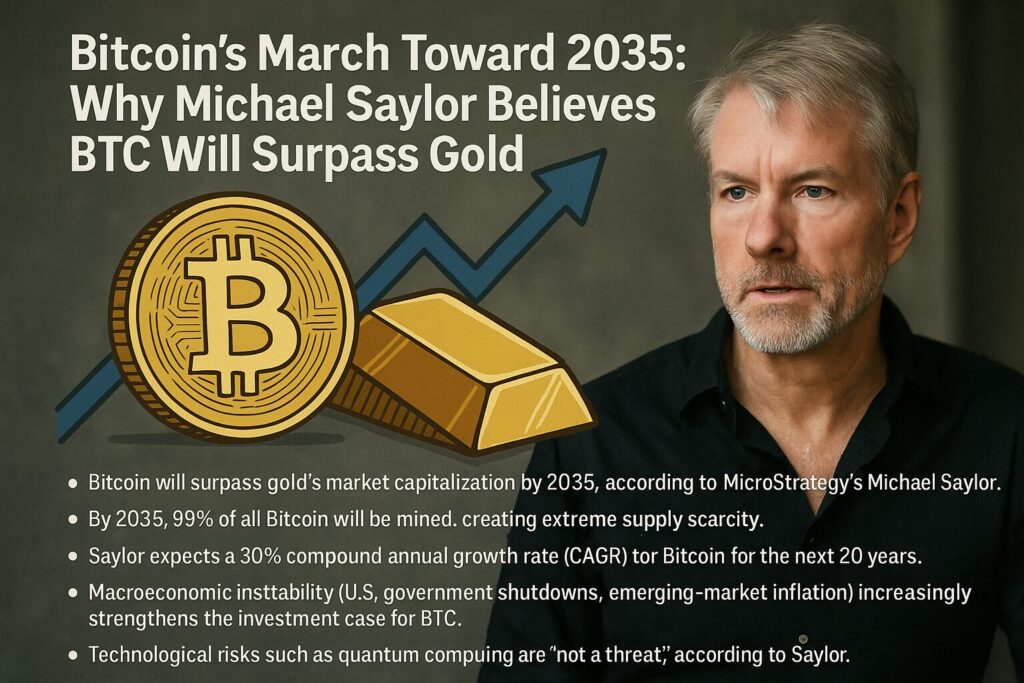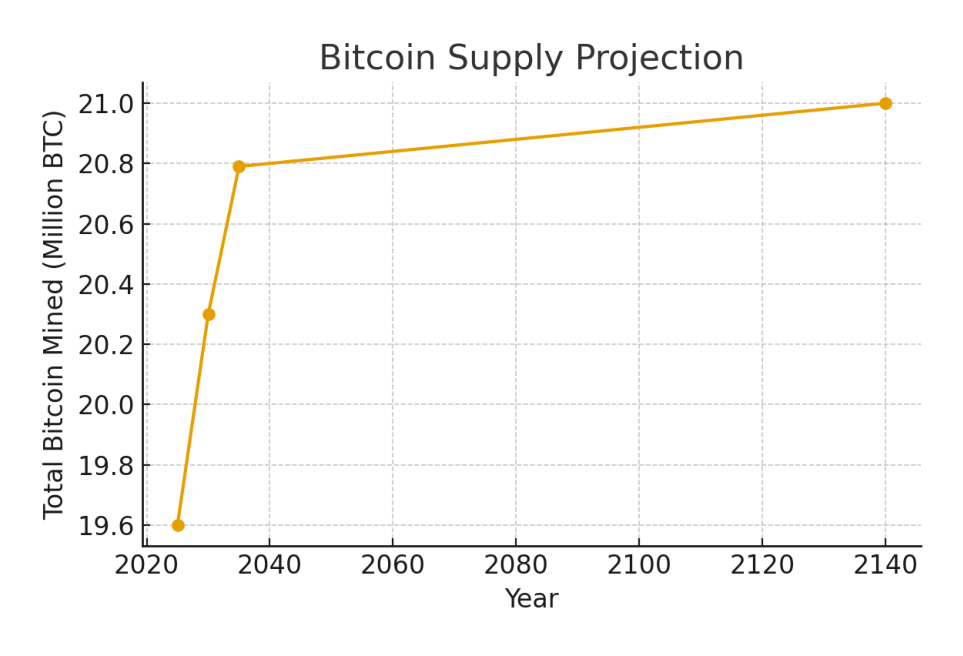
Main Points :
- Bitcoin will surpass gold’s market capitalization by 2035, according to MicroStrategy’s Michael Saylor.
- By 2035, 99% of all Bitcoin will be mined, creating extreme supply scarcity.
- Saylor expects a 30% compound annual growth rate (CAGR) for Bitcoin for the next 20 years.
- Macroeconomic instability (U.S. government shutdowns, emerging-market inflation) increasingly strengthens the investment case for BTC.
- Technological risks such as quantum computing are “not a threat,” according to Saylor.
- Bitcoin’s borderless, trust-minimized design gives it unique resilience compared to fiat currencies.
Introduction: The New Digital Gold Rush
Bitcoin has undergone numerous narrative shifts over the past decade—from an experimental internet currency to a hedge against inflation, and now, according to Michael Saylor, a forthcoming replacement for gold as the world’s premier store of value. In his latest comments, Saylor described the current global environment as a “digital gold rush”, asserting that Bitcoin will surpass gold by market capitalization by 2035.
This prediction is not grounded in hype but in Bitcoin’s structural mechanics, mining schedule, and the accelerating macroeconomic chaos around the world. In this article, we explore the foundations of Saylor’s argument, cross-analyze it with recent global economic developments, and evaluate whether Bitcoin may truly become the defining asset class of the 21st century.
1. Bitcoin’s Supply Horizon: Why 2035 Matters
One of Saylor’s strongest points is that 2035 marks the year when 99% of all Bitcoin will have been mined. With a fixed cap of 21 million coins, Bitcoin becomes increasingly scarce as issuance diminishes every four years through halvings.

The residual 1% will take 100+ years to mine due to block reward halving every four years. This asymptotic issuance schedule means:
- Bitcoin is the most predictably scarce asset ever created.
- No central bank or authority can change the supply.
- Scarcity increases monotonically, approaching full saturation.
In contrast, gold supply expands by roughly 1.5–2% per year. Even modest increases dilute gold’s scarcity premium, while Bitcoin’s supply becomes exponentially harder to obtain.
Why Scarcity Converts to Value
Saylor argues that if Bitcoin maintains even 30% annual growth, it will mathematically overtake gold’s market cap:
- Gold Market Cap (2025): approximately $15 trillion
- Bitcoin Market Cap (2025): approximately $1.3 trillion
At 30% CAGR, BTC reaches gold parity before 2035.
This scarcity dynamic—combined with a fixed cap—forms the backbone of Saylor’s bold forecast.
2. Macroeconomic Turbulence: Fuel for Bitcoin’s Ascent
Saylor points to the U.S. government’s recurring shutdown threats as evidence of systemic fragility in fiat systems. These shutdowns expose:
- Debt-driven government spending
- Political gridlock
- Dependence on central authority
- Erosion of institutional trust
In emerging markets—from Argentina, Nigeria, Turkey, Lebanon, to parts of Asia and Africa—local currencies face hyperinflation, capital controls, or instability. Bitcoin presents a stark alternative: a borderless, non-sovereign monetary network.
For investors in volatile economies, Bitcoin functions as a:
- hedge against currency collapse,
- tool for wealth preservation, and
- instrument for global financial inclusion.
Saylor highlights this global relevance by noting that Bitcoin has no headquarters, no CEO, no workforce, and no political attachment. It cannot be seized by a failing government or debased by monetary mismanagement.
3. “Owning Bitcoin Means Owning 1/21,000,000 of the World’s Money”
A powerful metaphor Saylor uses is that Bitcoin represents 21 million shares of global economic energy. Each Bitcoin is mathematically one unit out of a finite and immutable total.
Unlike gold, Bitcoin is:
- infinitely divisible,
- instantly transferable across borders,
- verifiable without third parties,
- immune to physical deterioration, and
- accessible to anyone with an internet connection.
This accessibility is key for the 1.7 billion unbanked people globally. While gold ownership requires vaults, storage, physical security, and intermediaries, Bitcoin’s custody can be handled entirely by a private key—or a non-custodial wallet, like those increasingly adopted in emerging markets.
4. Comparing 2019 to 2025: Why Bitcoin’s Surge Potential Is Higher Now
Saylor and many analysts argue that 2025 is fundamentally different from previous bull cycles. Key differences:
Institutional Differences
- Bitcoin ETFs approved in the U.S., Europe, and parts of Asia
- MicroStrategy, Tesla, and other corporations holding BTC
- Major pension funds and sovereign wealth funds exploring BTC allocation
Technological Infrastructure
- Lightning Network expansion
- Non-custodial wallet adoption
- Global merchant integrations
- Major custodial frameworks
Macro Backdrop
- Multi-polar geopolitics
- U.S. monetary uncertainty
- Higher global debt ratios
- Increasing inflation tail risks
These elements together make Bitcoin’s upside “more structurally supported than in any prior cycle.”
5. Quantum Computing and AI Are “Not a Threat”
Critics often claim Bitcoin could be broken by quantum computers or compromised by AI systems. Saylor dismisses this thoroughly:
- Bitcoin’s protocol upgrades continuously
- Cryptographic standards evolve
- Hardware and software security is not static
- Threat models advance alongside technology
The broader cryptographic community agrees that quantum-resistant algorithms can be implemented long before quantum systems become powerful enough to crack Bitcoin’s elliptic curve signatures.
Saylor likens Bitcoin’s adaptability to that of Apple or Microsoft:
“As their software evolves, the Bitcoin protocol will evolve. Bitcoin is not frozen in time.”
This resilience is one of the reasons BTC has survived multiple “death predictions” across the past decade.
6. Market Cap Trajectory: Can Bitcoin Really Overtake Gold?
To evaluate Saylor’s prediction, we model a hypothetical 30% annual BTC market cap growth:

This illustrates how Bitcoin’s market value could expand under sustained institutional accumulation, increasing scarcity, and adoption as a global reserve instrument.
Key Drivers Toward $15 Trillion Market Cap
- Institutional allocation (1–5% portfolios)
- Sovereign wealth fund adoption
- Growing acceptance of BTC as treasury reserve
- Retail adoption in unstable economies
- Global macro uncertainty
If even a fraction of these materialize, BTC surpassing gold is mathematically feasible.
7. Bitcoin as a Global Hedge Against Geopolitical Risk
Saylor emphasizes Bitcoin’s neutrality:
- It is not tied to any government
- It is immune to geopolitical weaponization
- It cannot be inflated to finance war
- It cannot be sanctioned in the traditional sense
- It is unaffected by regional catastrophes (earthquakes, famines, political collapse)
This makes Bitcoin uniquely suited for a fractured global era, where trust in traditional institutions continues to erode.
Conclusion: Will Bitcoin Surpass Gold by 2035?
Michael Saylor’s prediction is bold—but not without merit. The convergence of factors below paints a compelling picture:
- Predictable scarcity approaching full saturation
- Increasing macroeconomic instability
- Institutional and sovereign adoption
- Technological resilience
- Global financial inclusion
- Network-driven monetary premium
If Bitcoin maintains its long-term trajectory—and if the world continues to search for an apolitical, borderless, digitally-native store of value—then surpassing gold by 2035 is not unrealistic.
The next decade will determine whether Bitcoin becomes the premier global asset for wealth preservation, or simply one powerful alternative among others. For investors, innovators, and emerging-market participants, the coming years may represent the most important window in Bitcoin’s history.

